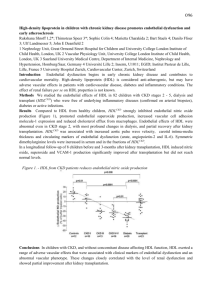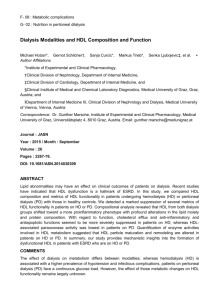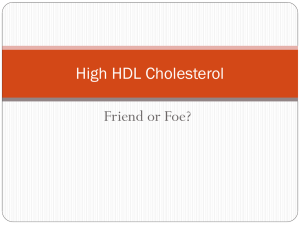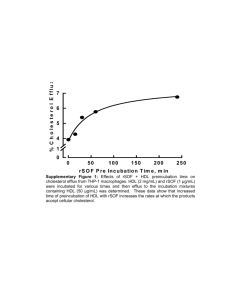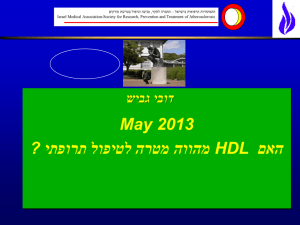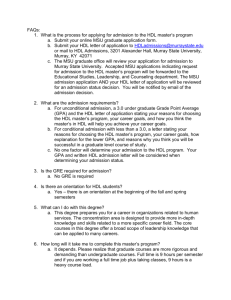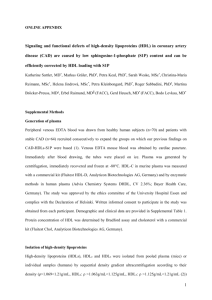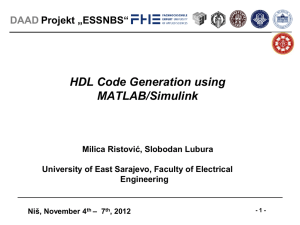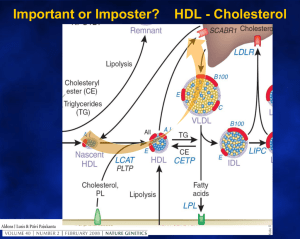ATVB 2011
advertisement
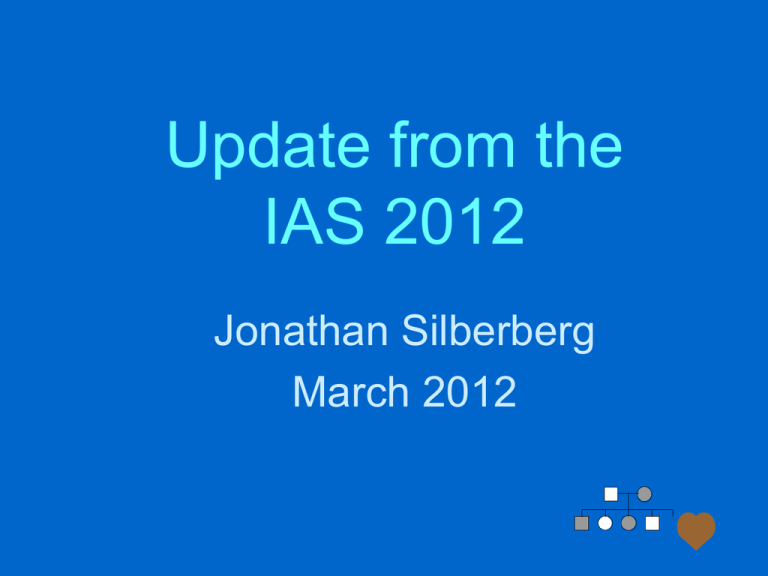
Update from the IAS 2012 Jonathan Silberberg March 2012 overview New pathways to chd Hdl therapy Mast cells, T & B cells, chemokines microRNAs AAA, diabetes, alzheimers 796 abstracts niacin • General agreement that AIM-high (NEJM Nov 2011) was underpowered • Awaiting HPS2-THRIVE n=25000 • Effects on HDL and LDL • Induces heme-oxygenase 1, cellular protective, inhibits vascular inflammation in non-lipid models Kastelein, Wu, others HDL and diabetes • Low HDL predicts future diabetes • Mechanism is non-insulin mediated glucose uptake, via AMP kinase • Cellular fuel gauge in active tissues eg skeletal muscle, preserves ATP • HDL rx lowers blood glucose and also increases insulin, rescues beta cell B Kingwell, Baker IDI Reverse transport ABC-A1 SRB-1 reverse transport reverse transport + free cholesterol apoA1 phospholipid LCAT HDL3 CETP vldl HDL2 HDL infusion • Rvx-8 • Orally active, increases apoA1 • SUSTAIN trial, ASSURE ivus • Cerenis cer001 • More potent than apoA1 Milano • Ivus trial ChiSquare AHA 2012 HDL infusion (2) • CSL112 • Nascent HDL discs • Increase ABC-a1 dependent efflux • ACC 2013 • Delipidated HDL • Brewer et al JACC 2010;55:2727 HDL: questions • Does it matter whether HDL acquires cholesterol via ABC-A1 (preBeta and delipidated HDL) or ABC-G1 (mature HDL) transporters? • Infusions show reduction in plaque volume, vessel wall inflammation • Equivalent to 2 y statin treatment HDL controversies • • Is CETP inhibition the opposite of pre-beta HDL treatment? Which HDL functions need cholesterol efflux, and which are due to other proteins associating with HDL? microRNAs • “just another way to control gene expression” • Or are they special? • One microRNA can repess numerous mRNAs • Stable in plasma, hide in lipid carriers eg LDL, HDL, exosomes ATVB 2011; 31:2383 ATVB 2011; 31:2378 microRNAs from plaque • 250 from monocytes, 80 exported • 140 from dendritic cells, 80 exported • Each cell type transmits unique signature to HDL via microRNA • Delivers inflammatory signal to liver • How organs communicate with each other miR223 • most abundant in plaque • Upregulated in FH (LDL receptor defect); one of 22 miRs abnormal • Downregulates several genes and enzymes involved in lipid metabolism • Opposite in NASH Mast cells • Contribute to plaque rupture • Subendothelial, accumulate in neovascularised areas • Immediate degranulation, chymase • Activates MMPs (collagenases), degrade fibronectin which anchor SMC to matrix. Apoptosis from loss of survival signal T cell response to oxLDL • Dendritic cells patrol artery, present antigen to T-cells in regional LN • Effector T cells are specific; reenter arterial wall & initiate secondary cascade with macrophages etc • Il-10 redirect dendritic cell to Treg, tolerant phenotype • prospects for specific immunorx Hanson Nature Immunol 2011 B cells • B1 cells innate immunity • Antigen independent, atheroprotective, remove oxLDL and apoptotic debris • B2 adaptive immunity • Bone marrow derived, activated by BAFF, targetted by rituximab • Expressed in unstable plaque, predicts events Mallat, Cambridge chemokines • • • • Mouse models of early atherosclerosis Noel & Weber Nature Medicine 2011 Cell recruitment, survival Specific regulation, not general antiinflammatory effect • Best target platelet-derived peptide • ?regional delivery of miRNA Alzheimers >65yo • CNS lipoproteins resemble HDL but major apo is E, not A1 • aBeta protein fragment is degraded by macrophages after lpE uptake, needs lipid-rich particle • E4/E4 onset 17 y early • E4/other onset 10y early • ?LXR agonists for short-term Wellington Vancouver

